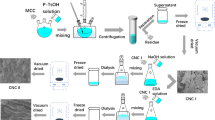Abstract
We investigated the crystal structure of alkali-celluloses, Na-cellulose IIA and II(Cu), formerly known as Na-cellulose IIB, by synchrotron X-ray diffraction. Na-cellulose IIA, formed from cellulose I by high-concentration NaOH treatment, has a fiber repeat of 15 Å and a threefold-like helical conformation. Na-cellulose II(Cu), prepared by treating cellulose I with copper-saturated alkali solution, also has a fiber repeat of 15 Å with threefold helical symmetry. Incorporation of Cu(II) ions into cellulose was confirmed by multiwavelength anomalous diffraction. Monitoring by X-ray diffraction revealed that the formation of this complex from cellulose I is remarkably slow, probably because of the involvement of copper ion. The stability of alkali-cellulose II(Cu) was tested to estimate the influence of the presence of copper in the crystal. Na-cellulose II(Cu) characteristically dissolved in aqueous ammonia solution, indicating strong coordination of copper ion to cellulose.





Similar content being viewed by others
References
Alexander LE (1979) X-ray Diffraction Methods. In: E. Robert (Ed) Polymer Science Kreiger, New York, pp 423–424
Hendrickson W (1991) Determination of macromolecular structures from anomalous diffraction of synchrotron radiation. Science 254:52–58
Langan P, Nishiyama Y, Chanzy H (2001) X-ray structure of mercerized cellulose II at 1 Å resolution. Biomacromolecules 2:410–416
Miyamoto I, Inamoto M, Matsui T, Saito M, Okajima K (1995) Studies on structure of cuprammonium cellulose 1. A circular dichroism study on the dissolved state of cellulose in cuprammonium solution. Polym J 27:1113–1122
Nishimura H, Sarko A (1991) Mercerization of cellulose IV. Crystal and molecular-structure of Na-cellulose IV. Macromolecules 24:771–778
Nishimura H, Okano T, Sarko A (1991) Mercerization of cellulose V. Crystal and molecular-structure of Na-cellulose I. Macromolecules 24:759–770
Nishiyama Y, Okano T (1998) Morphological changes of ramie fiber during mercerization. J Wood Sci 44:310–313
Nishiyama Y, Kuga S, Okano T (2000) Mechanism of mercerization revealed by X-ray diffraction. J Wood Sci 46:452–457
Nishiyama Y, Langan P, Chanzy H (2002) Crystal structure and hydrogen-bonding system in cellulose 1β from synchrotron X-ray and neutron fiber diffraction. J Am Chem Soc 124:9074–9082
Nishiyama Y, Sugiyama J, Chanzy H, Langan P (2003) Crystal structure and hydrogen bonding system in cellulose Iα, from synchrotron X-ray and neutron fiber diffraction. J Am Chem Soc 125:14300–14306
Nishiyama Y, Wada M, Hanson L, Langan P (2010) Time-resolved X-ray diffraction microprobe studies of the conversion of cellulose I to ethylenediamine-cellulose I. Cellulose 17:735–745
Okano T, Sarko A (1984) Mercerization of cellulose. I. X-ray diffraction evidence for intermediate structures. J Appl Polym Sci 29:4175–4182
Okano T, Kim NH, Sugiyama J (1989) Supermolecular structure of alkali-swollen cellulose. Cellulose, structural and functional aspects, Ellis Horwood, London, pp 93–96
Porro F, Bédué O, Chanzy H, Heux L (2007) Solid-state 13C NMR study of Na-cellulose complexes. Biomacromolecules 8:2586–2593
Reeves RE (1944) The optical rotation of cellulose and glucosides in cuprammonium hydroxide solution. Science 99:148–149
Schweizer E (1857) Das Kupferoxyd-Ammoniak, ein Auflösungsmittel für die Pflanzenfaser. J Prakt Chem 72:109–111
Sobue H, Kiessig H, Hess K (1939) Das system cellulose—Natriumhydroxyd-Wasser in Abhaeugigkeit von der Temeratur. Z Phys Chem B43:309–328
Su X, Kimura S, Wada M, Kuga S (2011) Stoichiometry and stability of cellulose-hydrazine complexes. Cellulose 18:531–537
Wada M, Nishiyama Y, Langan P (2006) X-ray structure of ammonia-cellulose I: New insight into the conversion of cellulose I to cellulose IIII. Macromolecules 39:2947–2952
Whitaker PM, Nieduszynski IA, Atkins EDT (1974) Structural aspects of soda-cellulose II. Polymer 15:125–127
Acknowledgments
The authors thank the Japan Synchrotron Research Institute (JASRI) for provision of BL40B2 beam time at SPring-8 (2012A1549). We thank Dr. Y. Nishiyama for valuable discussions and comments during the writing of this work. This study was supported by a grant-in-aid for JSPS fellows (no. 23-2362).
Author information
Authors and Affiliations
Corresponding author
Rights and permissions
About this article
Cite this article
Ogawa, Y., Hidaka, H., Kimura, S. et al. Formation and stability of cellulose–copper–NaOH crystalline complex. Cellulose 21, 999–1006 (2014). https://doi.org/10.1007/s10570-013-9977-4
Received:
Accepted:
Published:
Issue Date:
DOI: https://doi.org/10.1007/s10570-013-9977-4




